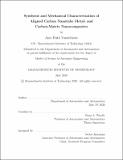Synthesis and mechanical characterization of aligned carbon nanotube metal- and carbon-matrix nanocomposites
Author(s)
Vanderhout, Amy Ruth.
Download1191824356-MIT.pdf (31.59Mb)
Other Contributors
Massachusetts Institute of Technology. Department of Aeronautics and Astronautics.
Advisor
Brian L. Wardle.
Terms of use
Metadata
Show full item recordAbstract
Carbon nanotube (CNT) assemblies are seeing increasing use in engineering applications due to their advantaged, mass-specific physical properties. The high strength-to-weight ratio, electrical and thermal conductivity, and elastic properties make CNTs ideal for many aerospace, automotive, and electrical applications. In structural materials, CNTs are an outstanding candidate to provide nano-reinforcement, both in hybrid composites and nanocomposites, and they have been found to improve the hardness, yield strength, and conductivity of their matrix material. Additional enhancement of these matrices can be realized by using aligned CNTs (A-CNTs) of increased volume fraction, as explored in this work. In this thesis, ceramic matrix nanocomposites (CMNCs), specifically A-CNT/carbon matrix nanocomposites (A/C-NCs), are synthesized by first infusing a carbon precursor resin into A-CNT arrays with CNT volume fractions (v[subscript f]) ranging from 1-30 vol%, and then pyrolyzing the resin to create a carbon matrix around the A-CNTs. Previous work with A/C-NC hardness suggests that such a lightweight, superhard material may rival the density-normalized hardness of diamond at high v[subscript f]. Various processes were refined and tested in this work, yielding microscale void-free A/CNCs up to 30% v[subscript f], with an ~7% improvement in hardness over baseline pyrolytic carbon (PyC) for 1% v[subscript f] A/C-NCs and <10% improvement in hardness for 5% v[subscript f] A-CNTs. A reinfusion (i.e. an initial infusion/pyrolysis cycle with three additional reinfusion/pyrolysis cycles) procedure was developed and implemented, and testing is recommended as immediate future work. Although hardness determination of these reinfused samples is left for future work, the X-ray CT images of the final A/C-NCs after the fourth infusion show excellent infusion and few voids, suggesting that high hardness will be achieved. This thesis also explores and develops synthesis techniques for metal matrix nanocomposites (MMNCs), focusing on an aluminum matrix. As the surface energy of ACNTs is not conducive to wetting by Al (and many other metals), this surface energy must first be altered to allow Al matrix infusion for consistent composite fabrication. TiO₂ is conformally decorated onto ~100 [mu]m-tall A-CNT arrays via atomic layer deposition (ALD). A reduction process for the TiO₂ coating was developed, and a reduction to TiH₂ was determined to be promising, as the TiH₂ will not oxidize prior to Al infusion but can easily be reduced in a vacuum oven apparatus designed specifically to meet the needs of Al infusion. Towards MMNCs, both solder and aluminum matrices are infused into the TiO₂-decorated A-CNTs. The solder experiments yielded mixed success, as the results suggest that both the reduction and the vacuum infusion steps are important factors determining successful wetting. Although Al infusion into an A-CNT array was unsuccessful without a dedicated Al infusion apparatus, molten Al was found to wet Ti well, which suggests that the Ti coating may allow for successful A-CNT wetting. Additional recommendations are provided to further refine the A/Al-NC fabrication process to improve Al infusion.
Description
Thesis: S.M., Massachusetts Institute of Technology, Department of Aeronautics and Astronautics, May, 2020 Cataloged from the official PDF of thesis. Includes bibliographical references (pages 203-224).
Date issued
2020Department
Massachusetts Institute of Technology. Department of Aeronautics and AstronauticsPublisher
Massachusetts Institute of Technology
Keywords
Aeronautics and Astronautics.